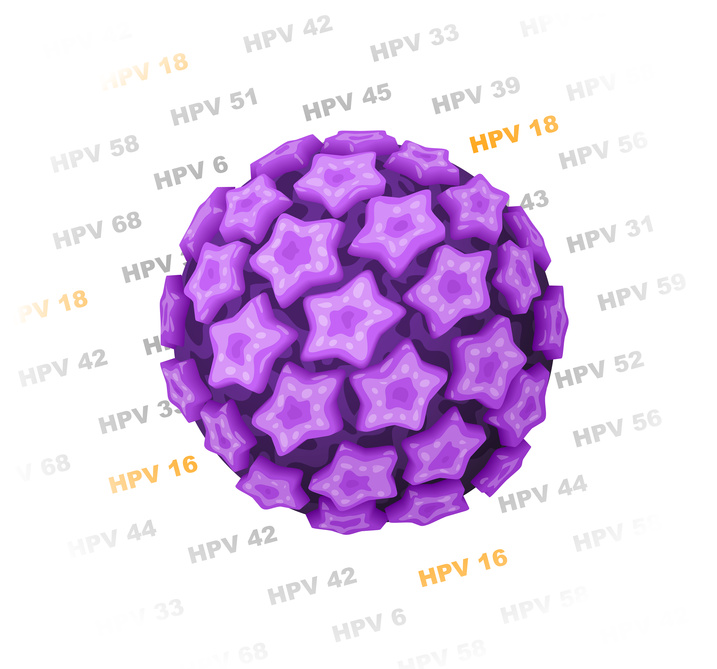
Cancer of cervix- HPV screening program
What is HPV?
Human papillomavirus, or HPV, is a common virus. Currently, 118 types of HPV are known. Most of them are harmless and the infection will disappear with no symptoms.
Only 40 types of HPV are spread by sexual contact. Based on the risk, we divide them into low risk HPV(lrHPV) and high risk HPV(hrHPV). Low-risk, non-cancerous HPV types can cause benign cervical changes (abnormal, but not cancerous changes) and genital warts. High-risk HPV infections induce epithelial cell changes, e.g. on the cervical surface, which can lead to cancer.
WHAT IS THE RELATIONSHIP BETWEEN HPV INFECTIONS AND CERVICAL CARCINOMA?
Nearly 100 % of all cervical cancers are induced by human papillomavirus (HPV) infection. This sexually transmitted infection is very widespread.
Women aged 20-25 years (almost 50 %) and aged 45-50 years are most commonly infected. Up to 80 % of women and men are infected with HPV during their lives, most of them shortly after the start of their sexual life. In most cases, HPV infection is eliminated by the immune system within 12-18 months.
HOW IS HPV TRANSMITTED?
HPV infection is a sexually transmitted disease. The transmission of infection occurs most often during vaginal or anal sex. However, contact with the infected partner’s skin in the genital area is sufficient to transmit it.
As sexual partners’ skin contact also occurs outside the condom-protected area, condom is not sufficiently effective in this case. There is also the possibility of transferring HPV from mother to child during childbirth.
How to protect yourself from HPV infection?
Currently, the most effective protection against HPV infection is vaccination. Vaccines available on the Czech market include Cervarix and Silgard. Cervarix provides protection against HPV16 and 18 and Silgard against HPV6, 11, 16, and 18. These vaccines are recommended for women and girls aged 10-25 years, and for girls aged 13 years they are fully covered by health insurance companies.
The vaccines are only prophylactic (preventative), they do not have any curative effects and do not affect ongoing HPV infection. Therefore, it is best to administer the vaccine to women before they start their sexual life. Vaccination is very beneficial even for sexually active women as the risk of new HPV infection persists for life. The effectiveness of the vaccine is the same for sexually active women as for sexually non-active women. Long-term HPV infection obtained prior to vaccination completion significantly reduces the efficiency. However, even for HPV positive women, or women who have already had HPV infection, the vaccine can be beneficial. Most HPV infections are only transient and lead to the formation of very few protective antibodies, therefore, without vaccination, precancerous changes may occur due to a recurrence of infection with the same type of HPV.
A very effective protection against a number of sexually transmitted diseases is a condom which, however, may fail in the case of HPV infection. Its regular use reduces the risk of infection but does not completely eliminate it. The transmission of HPV infection occurs in skin contact during sexual intercourse, even outside the condom-protected area. HPV infection may be transmitted not only by sexual intercourse, but also through oral sex. The best strategy of protection against HPV infection is vaccination against HPV, restrained sexual life, and observing essential hygienic habits.
What about men and HPV?
In men, genital HPV infection causes cancer of the rectum or penis, and genital warts. Most men infected with HPV belong to the 30-34 age group, but at the age of 18-19 years, HPV infection was found in nearly 20 % of cases. HPV affects male fertility. Sperms of HPV positive men have markedly reduced mobility, which can lead to decreased fertility. HPV positive men put at risk not only their sexual partners, but also their future children.
HPV positivity of the parents, and subsequently the fetus, increases the risk of spontaneous abortion. Possible risks associated with the health of an HPV positive child have not yet been explained. Men can be protected against HPV infection in the same way as women by vaccination, sexual restraint and essential hygienic habits.
What is cervical carcinoma?
Uterine cervix is the outer part of the cervix located at the end of the vagina at the entrance to the uterus. In the case of cervical carcinoma, uncontrolled proliferation of HPV infection-altered cells occurs in this region. Cervical carcinoma is the third most common cancer in women, just after the breast and colon cancers, and it affects women of all ages.
Tumour development is preceded by long-term HPV infection and precancerous changes. Every year, cervical cancer is diagnosed in more than 500,000 women worldwide and annually more than 270,000 women die from this disease. In most cases, HPV infection is necessary but not sufficient for cervical cancer to develop. Cervical carcinoma development is very slow and it is conditioned by long-term (over 6 months) infection with high-risk HPV types. HPV infection is mostly asymptomatic (90 % of women) and usually subsides spontaneously within 8-12 months.
Anatomy of the female reproductive system – location of the cervix and illustration of changes during the development of cervical carcinoma.
Self-sampling HPV test
Since 2012, the Cancer Research Foundation has been raising awareness of the risks associated with HPV infection. Therefore, they introduced a parallel screening for cervical cancer which is based on molecular methods.
For this purpose, the Evalyn Brush self-sampling test is used.
The Evalyn Brush self-sampling test (Rovers Medical) is a very sensitive and gentle device for collecting biological material using vaginal mucosa smear. The vaginal smear collected using this method will be examined for the presence of oncogenic types of human papillomavirus (HPV). The self-sampling HPV test consists of several components. The HPV test is distributed by the Czech Post. The envelope contains the information leaflet, the sampling device (test) with instructions for use, the client’s written consent to the examination, and a pre-addressed envelope.
.

